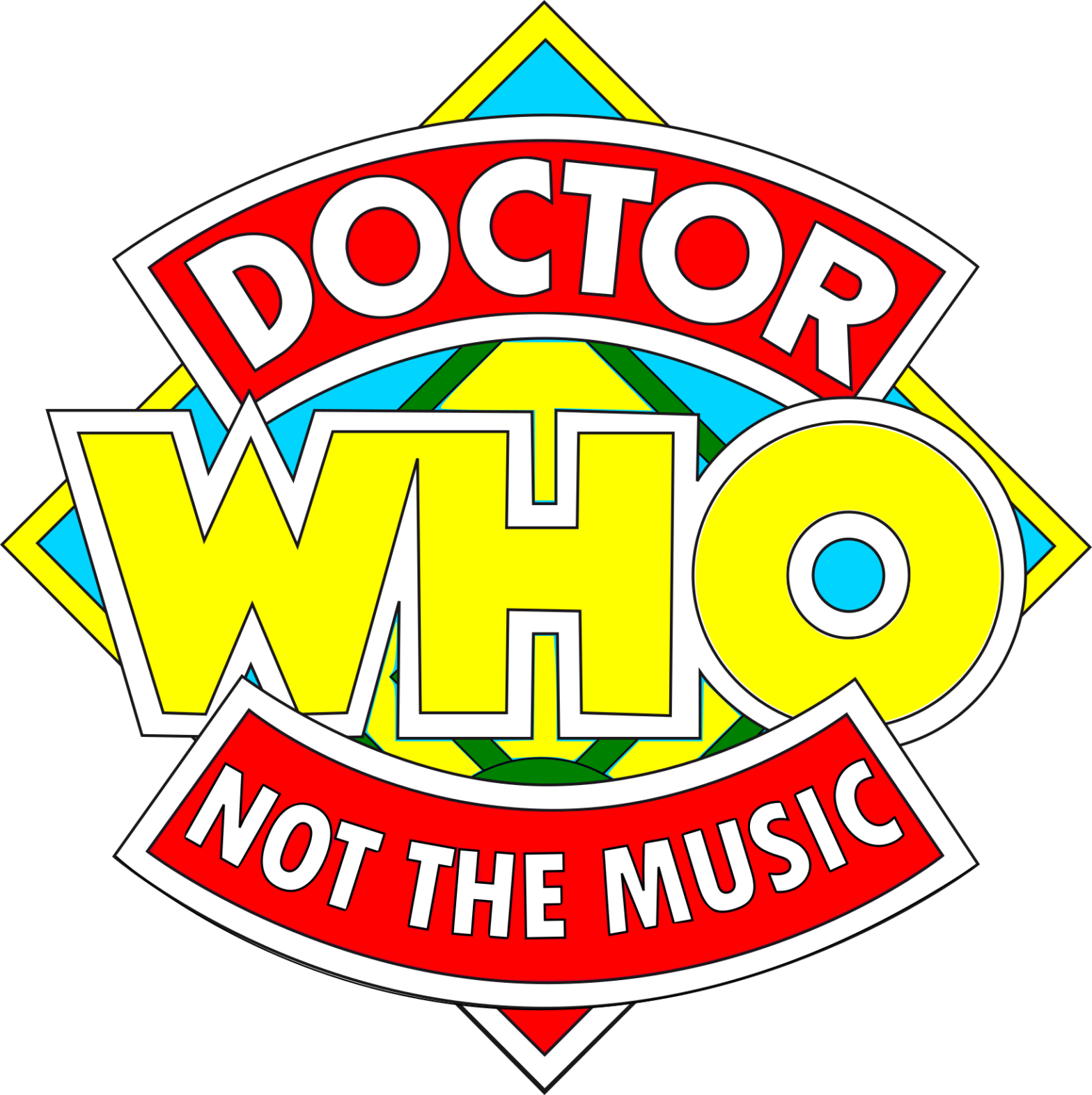Welcome to the third part of the third, well, part of Discographic Workshop. We’re still knee-deep in Doctor Who and this post is about the non-musical releases on the BBC Enterprises record labels. We’re starting with Doctor Who Sound Effects, of course, and there’s a story disc too – Genesis of The Daleks.
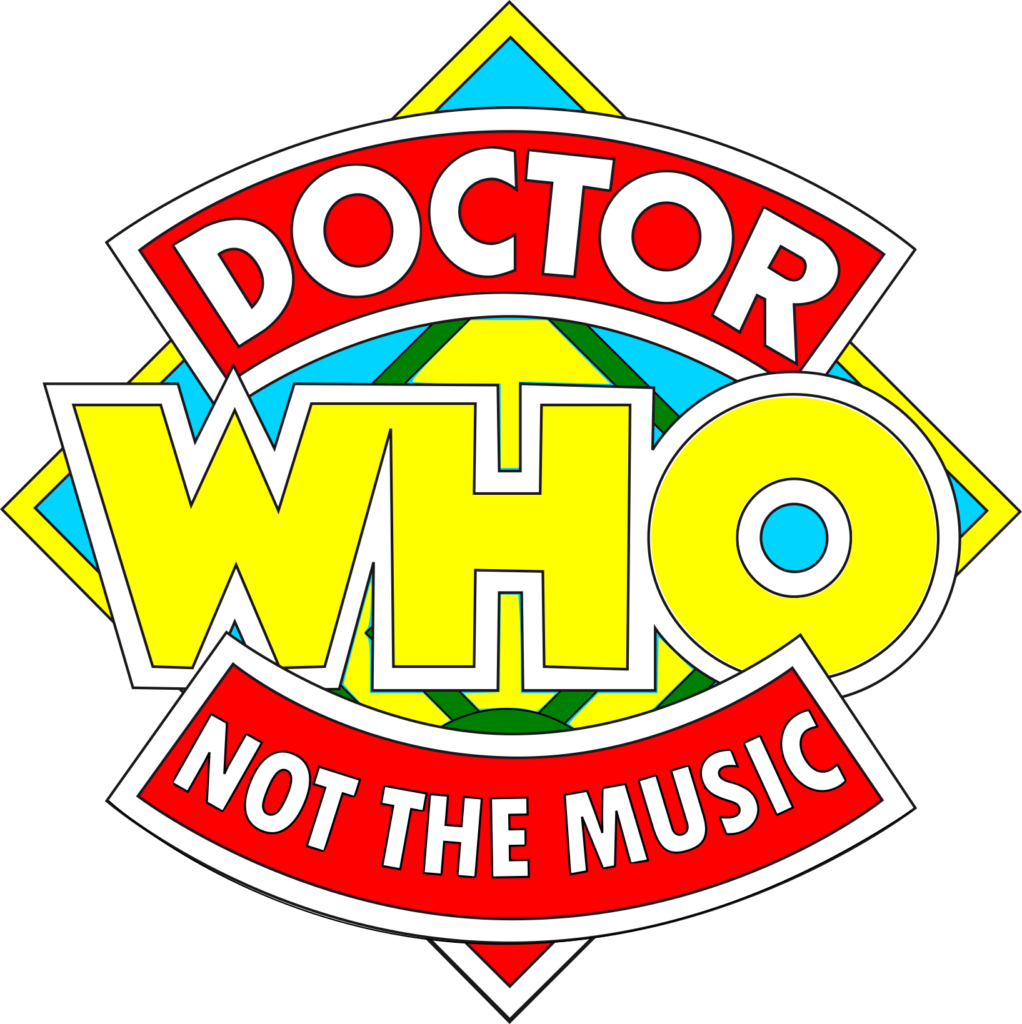
Contents
- Dick Mills
- Doctor Who Sound Effects
- Genesis of the Daleks
- Appendix
- Doctor Who Master FX Reels for LP
- Reel No. 2 – Beyond The Sun (The Daleks)
- Reel No. 3 – Beyond The Sun (The Daleks)
- Reel No. 6 – The Dalek Invasion of Earth
- Reel No. 8 – The Chase
- Master 12 – The Tenth Plant – TRW 6534
- Master 19, Reel B – The Evil of the Daleks – TRW 6653
- Master 23. The Web of Fear – TRW 6762
- Master 24 – The Web of Fear – TRW 6762
- Master 27, Reel 3 – The Colony Of Devils – TRW 6787
- Master 36, Reel 4 – The Dominators – TRW 6824
- Master 40, Reel 1 – The Invasion – TRW 6908
- Master 41, Reel 2 – The Invasion – TRW 6908
- Master 42 – The Krotons – TRW 6942
- Master 45 – The Space Pirates – TRW 6986
- Master 48 – The War Games – TRW 7037
- Master 55 – Ambassadors of Death – TRW 7144
- Master 63 – Vampires from Space – TRW 7332
- Master 67 – Colony In Space – TRW 7340
- Doctor Who Master FX Reels for LP
- Some Sources
Dick Mills
Doctor Who Sound Effects is very much a Dick Mills album and Genesis of the Daleks is another Dick and Dudley affair, with the exception of the theme, which was a Dick and Delia realisation! I will get more into the Dick Mills story in part 4 of Discographic Workshop, which is all about sound effects. Meanwhile, here’s a short introduction to the effects specialist.
Dick Mills took over from Brian Hodgson and created the sound effects for Doctor Who right up until its cancellation, in 1989. Mills was at the Workshop longer than anyone else, as well as his record-breaking run working on Doctor Who. He started there shortly after joining the BBC and didn’t leave until his retirement in 1993. An honorary doctor, he spent 35 years at Maida Vale making the noises that no one else could and during around half of those he was responsible for all of the DW sound effects.
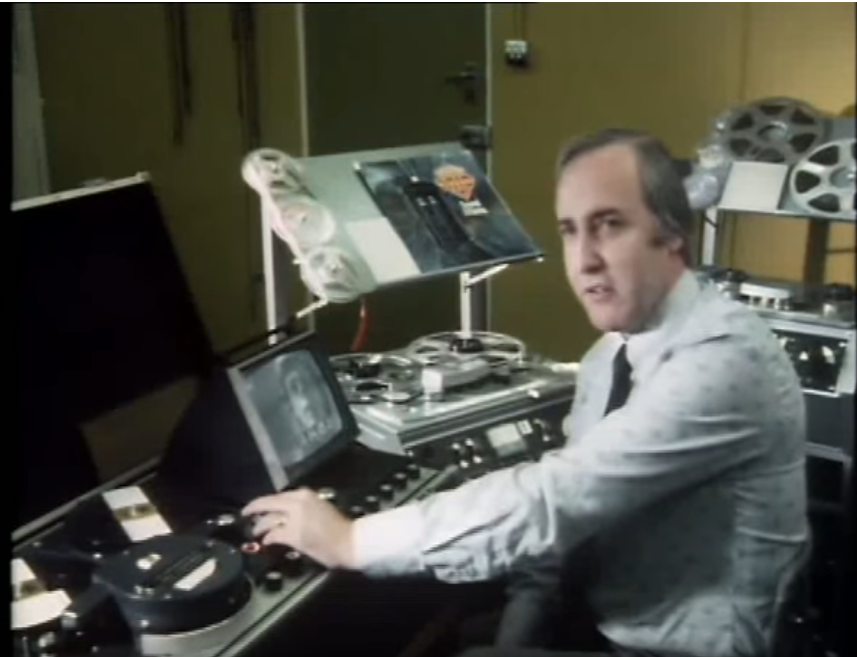
Honorary Doctor, Who Did Doctor Who Honours
Dick was at the very first Doctor Who meeting with Verity Lambert. He and Workshop Organiser Desmond Briscoe went to Ealing studios to meet her and get the ball rolling. After helping Delia Derbyshire with the theme Dick was then assisting Brian Hodgson with the special sound. They worked as a pair on the first few stories and then the Workshop decided to double their productivity by using one member of staff per project. Brian continued to work on the programme whilst Dick went about work on many other BBC productions.
“Dick? Would you care to stop what you’re doing and attack the piano for me, please”
Brian Hodgson ‘Tom Tom’ BBC TV
Hodgson left the Workshop in 1972. His last DW story was ‘Carnival of Monsters’, broadcast in early 1973, but made in the previous June (an unusually large gap between production and broadcast), but Dick had started to pick up work on the next story in series 10, ‘Frontier in Space’ (1973).
Due to the pairing of staff noted above, Dick was involved in the DW Special Sound from the start, but only as an engineering assistant. When Hodgson “to no-one’s surprise”(DM) announced his departure Briscoe asked Dick how he felt about taking over. Frankly, he gave him no option.
Desmond Briscoe, then Head of the Workshop, asked me ‘How
Dick Mills – Doctor Who Magazine 198
do you feel about doing Doctor Who?’ So I said ‘Have I got any choice?’ He replied ‘No!’ So I said ‘I’ll do it!’
As it happened Dudley was coming in at 4 PM that very day (or perhaps the following morning, depending on the version of events you listen to…) to do some of his soundtrack overdubs for ‘Frontier in Space’ on the Delaware synth. Dick and Dudley would form a successful bond in time. Still, with apparently no hand-over from Hodgson, Dick had to quickly pick up where his erstwhile colleague left off. Requests for ‘low-trajectory sounds’ from Simpson mystified Dick, to begin with, and it took a while for him to pick up the lingua franca, which the Australian had developed with Hodgson. Dudley could be fussy and any sound effect that could be mistaken for a duff musical note would reflect badly on the composer. Rather cheekily the Workshop provided Simpson with a special control knob, known as ‘option 4’ which he could twiddle to improve the sound. It didn’t actually do anything to the sound, but it seemed to keep him happy!
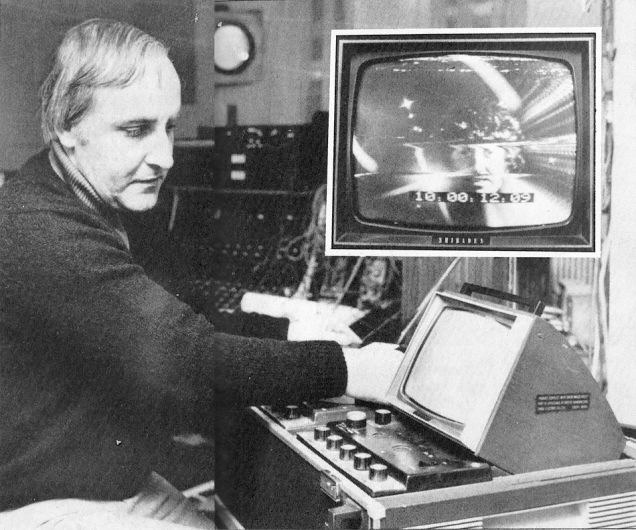
Dick’s basic method for sound effects was to use electronic means to create sounds for machines and natural sounds for, well natural elements. As more sound processing products came onto the market, Dick took full advantage. Flanging, phase shifting, harmonizers, delay and reverb came boxed and ready to use. However, the highly experienced Mills would still resort to tape, room ambience, repurposed BBC gear and whatever else was lying around to get things ‘just so’.
Mills feels that he only really hit his stride when Tom Baker took the lead role in 1974. By then he’d worked on nine series, which shows just how serious he was about his craft!
Doctor Who Sound Effects
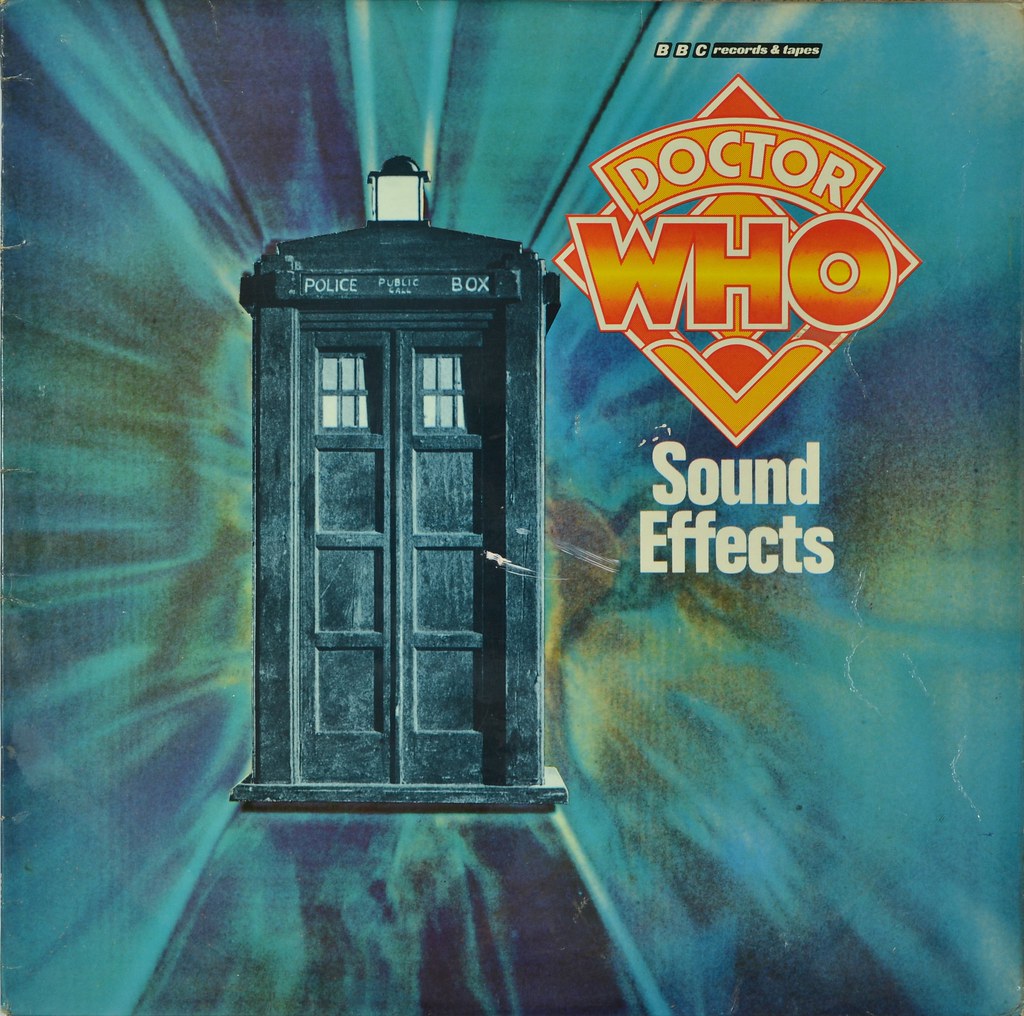
Inside Number Nineteen
I am going to return to the RWS contributions to BBC Records long-running ‘BBC Sound Effects’ series in a later part of Discographic Workshop. The DW chapter in that story is being told now because it fits in more neatly with the rest of the Who stuff. Suffice it to say, since 1969, BBC Records had been releasing albums of sound effects. By the time this one came out, eighteen previous volumes were available, so this edition was number 19. The naming and numbering of the sound effects is haphazard, but on the reverse of the sleeve there is a little “no. 19” next to the title and the on the spine is “DR.WHO SOUND EFFECTS NO.19”.
Shelf Load Of Tapes
When Verity Lambert told Mills and Briscoe that they would be making large demands on the Workshop, she wasn’t kidding. Every encounter with new technology or aliens called for a new and unique sound. Having the same noise for a Dalek gun and a Cyberman gun would undermine the reality of the show and simply wouldn’t do.
“Every programme’s a challenge, with its own unique set of problems no two spaceships or monsters will sound the same. Each is different.”
Dick Mills – ‘Sounds Peculiasr’ – Doctor Who Weekly 29, 1980
By the same token if the Doctor met the same aliens, gadgets, or whatever, it made no sense to re-make that sound. Indeed, it was expected to be the same sound. Hence, over the years, a large library of sound effects was built up. In the ‘Doctor Who: Masters of Sound’ documentary, Dick Mills and Brian Hodgson proudly show off their collection. Some 16 feet of shelving full of tape reels.
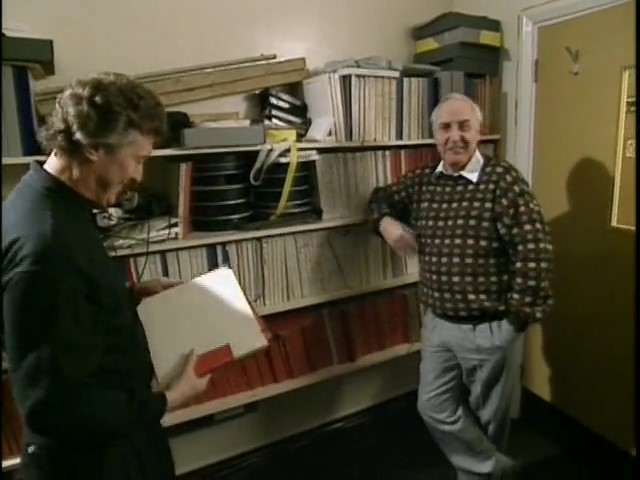
So, they had a ready supply of DW sound effects and as we’ll see later, the RWS had already been involved with the BBC Records’ Sound Effects Series. Also, there has always been an interest in how DW is made that runs parallel to the show itself. The RWS were involved in that fan engagement and were generally happy to share the secrets of their work. This LP is the most tangible example of that. The next logical step then was a DW sound effects record, but it still warrants a bit more explanation and context than that.
Classic Albums
To most people, including dedicated and otherwise open-minded DW fans the very existence of this album is a bit of a laugh. In fact, unconsciously for the most part, any album which doesn’t at least seem to be trying to compete with (ooh, let’s say) Sgt Pepper, is somehow ridiculous merely by existing in the same format. It invites ridicule. Its incongruity with the majority of LPs practically demands a wisecrack about: how well it placed in the charts; how danceable its grooves are; something about singing or humming along, and what, in short, the hell it thinks it’s doing, daring to be in anyone’s record collection? It actually un-nerves people, I think. If you could stand listening to the whole thing, when you could be appreciating something more conventionally entertaining, there must be something wrong with you. And they would be right, if you ignored all other entertainment and only listened to abstract noises you would be highly unusual, I suppose. Needless to say, if you were a DW fanatic, particularly in the days before the geeks inherited the earth, you were already an outsider. If you went as far as buying an album exclusively made up of sound effects from the show you were an extremist. Or maybe just, a kid who loved everything DW. Or an adult fan with an appreciation for the whole shebang (and brrrrrrzzz and shhhhhhheeeeeeewwww).
Fan Made
In the BBC programme ‘You, Me and Doctor Who, made for the 50th anniversary of DW (and which should have been a 12-part Ken Burns-esque encyclopedic series in my opinion) the presenter Dr Mathew Sweet spoke to the current generation of writers. The whole genre area of fan fiction gets a bad rap, for some good reasons, but I was struck by an audio adventure they played. “Amateur city” was New Who script editor Gary Russell’s assessment of an old cassette tape production (‘The Mutant Phase’), but there were sound effects on that tape. The thesis was that it was this era that trained a generation of creatives who would bring DW back to life in the new century. The DW sound effects played a small but important part in that. YOU had the tools. You had some of the same library of sounds that Dick Mills had. It was, for now, over to you.
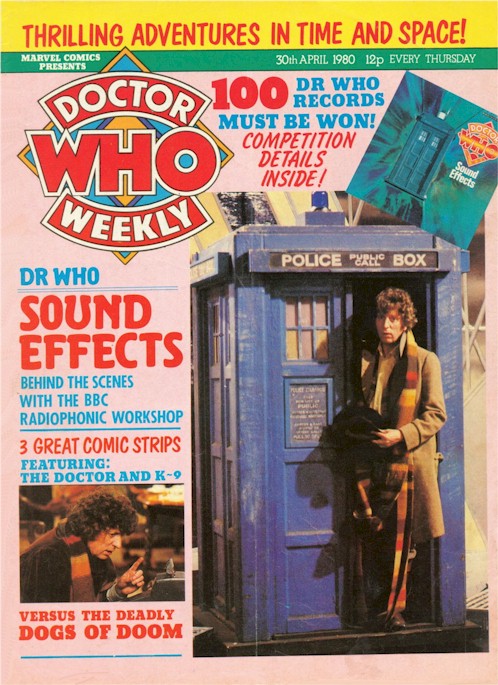
Credits Account
This album is produced by both sound designers (as they would be called now) as by 1978 Hodgson had returned to the Workshop (in 1977, in fact) and was running the daily activities as well as overseeing the overhaul and renovation of its studios.
The blurb isn’t credited to anyone in particular, but it was hand-written by Mills and included at the end of the track list he sent to BBC Records. We can also safely assume that he composed it because he was paid the standard fee of £25 for sleeve notes.
Everyone knows that Dr. Who’s Tardis is bigger on the inside than outside; and the selection of aural locations from the Doctor’s travels will equally broaden your horizons. No less than seven alien worlds are visited, together with some extra ordinary, extra-dimensional occurrences encountered on Earth (Sol. 3 in the Mutters Spiral). Add to these an audiogram of the Doctor’s own mind processes, Tardis operations, some weapons for self-defence and your galactic safety is ensured. Time-Lord. Note: A source of jelly-babies is recommended to complete the illusion of Time Travel.
Doctor Who Sound Effects sleeve notes – Dick Mills
Each effect is uncredited, but you can work out who did what. The earliest effect is track 2, atmosphere from ‘Death to the Daleks’ stated as being from Season 11, in early 1974. It’s actually much older having been with the Daleks from the beginning – 1963 to be precise. The latest effect is taken from the Season 15 finale ‘The Invasion of Time’, in March 1978. That means that all these story-specific effects are by Dick Mills. Thus tracks 8-13, Tardis interiors and the sonic screwdriver, with no specific story mentioned in the sleeve notes, are Brian Hodgson’s.
Brian’s Bible
This is how the album ended up, but that wasn’t always the plan. In the BBC Enterprises file on Doctor Who Sound Effects the first documents you find are lists of effects on tape reels at the RWS. Each page lists effects from a DW series in the 1960s. In the Masters of Sound Documentary Dick shows us a bound volume of these sheets and calls it “Brian’s Bible”. Only two of these effects are used on the final track list though. There are no accompanying memos or other correspondence on these sheets and no equivalent set for the later effects. Somehow this sheaf was passed to the people at the record label and they were kept on file.
Double Contrived Fantasy
I can only imagine what happened here. A double album seems wildly optimistic. A Brian side and a Dick side might have been fairer. A more comprehensive selection from the whole history of DW would have made sense too. In the end, the track list reflected the more recent history of the show and it’s debatable how many fans would recall or even have been alive for stories from ten to fifteen years earlier. Did Brian tell Dick that as he was doing the work he should take the lion’s share of the content?
Some of the selected effects have subsequently been made available on CD releases. You can’t completely recreate this selection yet though. Maybe something for a future compilation? I’ve added the list of proposed effects below.
Multi Track Review
When Dick Mills prepared his tracklist he used the name of the effect and the story it came from as written on his tape sheet. The problem there was that many of the DW stories had working titles which were changed before broadcast. No one spotted this before the record was released though, so that’s how they stayed.
Side 1
Side one begins with the sound of control rooms. Low-pitched throbs and humming are the order of the day here. Spaceships are alive with power and you have to be able to hear it.
- Central Control Room In Exillon City
- Oh dear, we are off to a bad start with the track titles and associated programmes
- ‘Doctor Who and the Exillons’
- The broadcast serial was, ‘Death to the Daleks’
- The Dalek Control Room might be “the scariest noise ever created”(@mumoss), but context is everything with these sounds.
- From ‘Death to the Daleks’
- Hodgson’s concept for this sound was that all Daleks have the same universal heartbeat.
- So, this is a Hodgson sound as although Death To The Daleks is from 1974 it is the same sound that is still used today for Dalek control rooms.
- Then we’re off outside, to sample the Metebelis III Atmosphere, which is swirling, whistling and also thrumming. Metebelis III is a beautiful place, but also hazardous.
- From ‘Planet of the Spiders’
- The Sontaran Field Major Styre’s Scouting Machine has a not unpleasant burbling, alternating with a not particularly pleasant buzzing undertone, but it seems to have developed a nasty whinnying which he should get checked out.
- From ‘The Destructors’
- Actually, it’s from The Sontaran Experiment
- These Dalek Hatching Tanks on Skaros(sic) seem to be in good working order – if they are supposed to sound like a bear with laryngitis snoring away at the back of its cave.
- This is from Genesis Of The Daleks
- See below for more on that…
- Skaros is meant to be Skaro though
- The Zygon Spaceship Control Centre takes us back to the womb-like humming, yet it seems to have been infested by some electronic birds.
- From ‘Doctor Who and the Zygons’ it says here.
- It was in reality called ‘Terror of the Zygons’
- A Sutekh Time Tunnel will be familiar to all fans of the rave classic ‘Spice’ by Eon (anyone?). It’s actually like a more calming version of the effects used to try and brainwash Harry Palmer in The Ipcress File (1965), created by none other than ‘Workshop Organiser Desmond Briscoe.
- From Pyramids of Mars
- The Interior of Xoanon is more meditative still and you will not be inclined to bother discovering what the exterior is like (if you did, you would be rewarded by finding Leela, so that might be worth your while…).
- From The Face of Evil
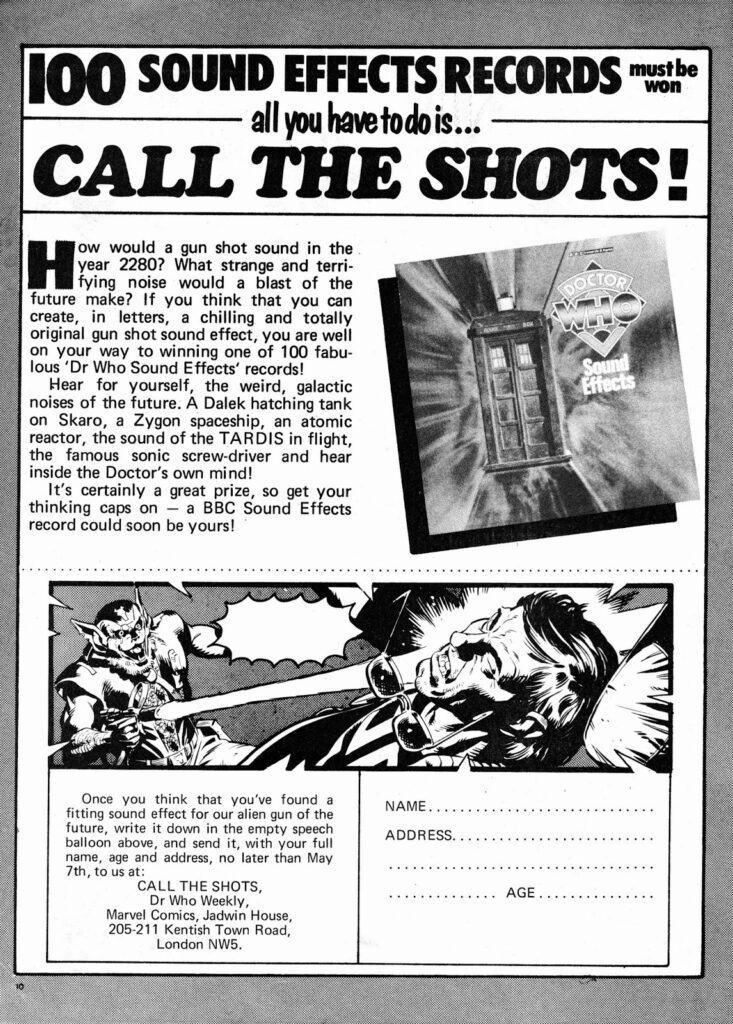
Side 2
At this point, the record flips over and we briefly get some more of the work of Brian Hodgson. Conspicuous by its absence is the Tardis take off and landing effect. That had already appeared on ‘Out of this World Sound Effects’ in 1976, and you’ll have to wait for Part 4 of Discographic Workshop for it to materialise. Dick notes this fact at the bottom of his notes to Mike Harding at BBC Records.
- The Shrine of The Sisterhood of Karn’s air-con needs a thorough service, but the bells and general ambience are relatively agreeable.
- From (Doctor Who and the) Brain of Morbius
- Next, we stumble into the Krall Disorientation Chamber, which could be anywhere (Derbyshire, maybe), before getting wrapped up in the ‘Madragora Helix’ and wishing that whoever designed this technology would find a way to make it stop making that noise.
- The Android Invasion
- The Curse of Madragora should be The Mask of Madragora
- We’re briefly surprisingly glad to be in the ‘Atomic Reactor…’ before becoming increasingly alarmed that it might be ‘…Running Wild’.
- The Hand of Death
- Another busted-up air conditioner is next, but this is being used as a Wind-mine Machine. If you need it for a wind mime, you are in the wrong place.
- From The Robots of Death
- The machine was probably just the sand mining machine and the working title had been ‘The Storm Mine Murders’ at one point.
- Time for a tipple to calm our nerves, so it’s off to the ‘Distillation Chamber’ but all we find is a hot drinks vending machine attempting to take our youthful (ahem) energy as well as our loose change, and then giving up.
- From The Talons of Weng Chiang
- What’s that noise now? And why is everything getting larger? Oh, it’s the Cloning and Miniaturisation Process as we head (literally!?) to the Inside of Dr. Who’s Mind. All I can say is that he’s got an EMS VCS3 synthesizer in there and he’s making full use of the spring-reverb.
- Both from The Enemy Within, allegedly
- It was later named The Invisible Enemy
- And suddenly we’re back to the Tardis Interior (In Flight) which apparently uses an extractor fan to achieve propulsion through the 5th dimension.
- Tardis Interior (Stationary) shuts that racket off, but there’s another one somewhere else that you can never quite locate.
- Suddenly the TARDIS Observation Screen Operates) via a noisy electric motor and the ‘TARDIS door opens‘ by means of something bubbling(?).
- The Sonic Screwdriver heralds another round of the Radio1 Roadshow’s ‘Bits and Pieces’ quiz, AKA Fission Gun (2 Blasts) followed by the weedier, but no less deadly Tesh Gun.
- From The Ark In Space and The Face of Evil
- The battle hots up as a Gallifreyan Staser Gun (3 Blasts) joins the fray,
- From The Deadly Assasin
- …which in turn draws more fire from a rather camp and glittery Vardan Gun.
- No such sparks from the more punchy Sontaran Gun, which is chased off by another report from a different Gallifreyan Gun.
- You would think the matter is now settled by a prolonged blast from the Dematerialiser Gun.
- All from The Invasion of Time
- Except no battle is complete without a Dalek Gun (3 Blasts)
- From Genesis Of The Daleks
- And we’re finally finished off by a Dragon Ray Gun – good shooting, Mr Sin!
- From The Talons of Weng Chiang
Sleeve Design
The front of the sleeve is essentially the same as the 1976 re-issue of the Doctor Who theme (RESL 11) in full colour. Albeit the colour has been changed from the titles to create a more attractive contrast of blue and green.
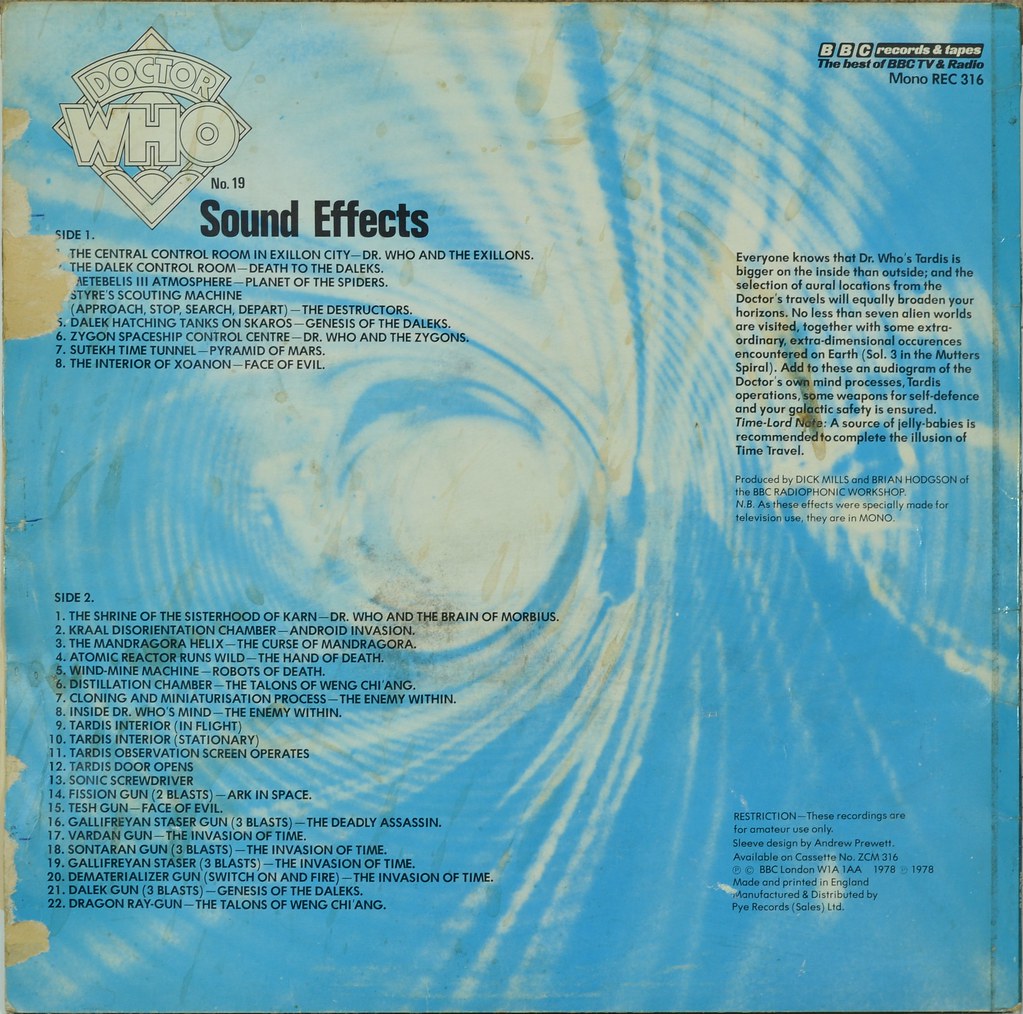
The back cover is another screenshot from the opening titles introduced in 1974. This has been rendered in monochrome.
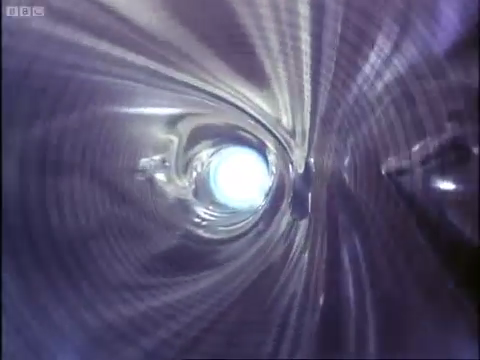
Reissues
On 1st May 1978, BBC Sound Effects no.19 Doctor Who Sound Effects (DWSFX) was issued in the UK on vinyl and cassette too (ZCM 316). In the first week it soled over 1500 copies on LP and nearly 400 on cassette.
Canadians also got an LP release in the same year (TRC 918) and the US got a cassette (C22316). American and Spanish fans had to wait till 1982 (BBC 22316) and ’83 (51.0123) respectively for LPs. Spain’s Diapson label called this release ‘Cienia Ficcion’ (translation Science Fiction). They then reissued the LP as a CD in 1990 (950031), but were beaten to the digital punch by Edelton who put out a CD in Germany, Austria and Switzerland in 1989.
Back in Britain, 2012 saw the issue of both a CD on AudioGo’s ‘Vintage Beeb’ (ISBN 978-1-4084-7055-8) label and an LP reissue (LPBBC24819). This AudioGo LP was available for Record Store Day


Genesis of the Daleks

Genesis of the Daleks was the fourth serial in the twelfth series of Doctor Who, broadcast in April 1975. Starring the fourth Doctor played by Tom Baker, it is roundly agreed to be one of the all-time best DW stories. It was given a fan pleasing nod on the 2023 Children In Need special, where we meet Dalek prototype presented by a still standing Davros.
The musical score was provided by regular composer Dudley Simpson and the Radiophonic element was added by sound effects stalwart Dick Mills.
Genesis of the Daleks was swiftly repeated in 1975 and then again in 1982 as part of a season of monster themed re-runs ‘Doctor Who and the Monsters. It wasn’t available to buy on VHS tape till 1991. In the meantime, this abridged audio version LP was the only tangible way that fans had to enjoy the adventure, save for the writer Terry Nation’s Target Books novelisation. But, of course…
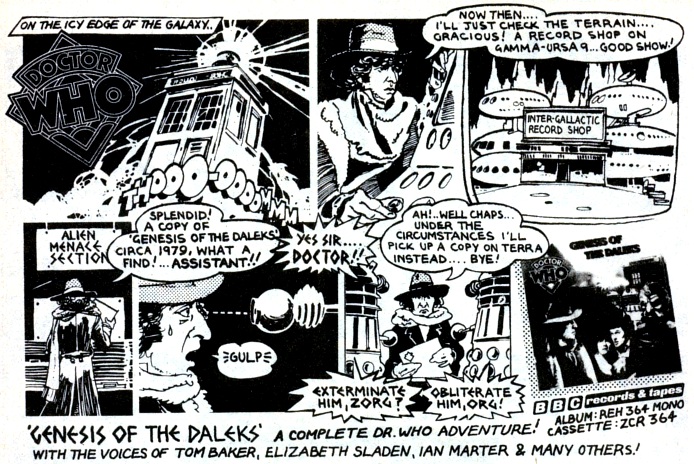
The abridgement of six 22-25 minute episodes is achieved through the use of a voice-over from Tom Baker, linking the action and filling in missing details where necessary. Some prefer the faster pace of this approach and it certainly has an edge of urgency thanks in no small part to Baker’s earnest delivery. It wasn’t his first such assignment. In 1976 the Argo label released a similarly formatted LP of the story ‘Doctor Who and the Pescatons’. Keeping things in the family, that record was partly put together by Brian Hodgson (amongst others) at his Electrophon Studios. ‘Genesis of the Daleks’ was an in-house BBC production though. “Narrative and Record Realisation” is credited to Derek Goom. If that name sounds familiar in the context of BBC records it’s because Derek Goom not only arranged (from works by J.S. Bach) the theme to ‘Juliet Bravo’, which was released in 1980 (RESL 84), but he also produced many records on the label around the late seventies.

Notably, for our purposes, he was responsible for ‘BBC Sound Effects no. 16 “Disasters”‘, a record which we’ll perhaps see a bit of in a later part of this series. Derek seems to disappear from the scene after the Juliet Bravo signature tune though – maybe it was enough to retire on!
Multi-Track Review
The track-listing of this album is non-existent with the sides being simply labelled Part 1 and Part 2. Nevertheless, I’m going to break the Radiophonic features down below.
Whose Who’s
The theme music is still credited to ‘Ron Grainer and the BBC Radiophonic Workshop’, which suggests either Brian Hodgson’s comments (citation needed) about Delia Derbyshire being careless with her copyright registration were correct, despite being given due credit for “realisation” on the 1973 single, or perhaps she had a problem with this version. It does have the controversial spangles on. Or maybe they just forgot? Dudley Simpson is credited with Incidental Music and Special Sound is, of course, by Dick Mills. On the TV recording there was also an uncredited grams operator, Gordon Phillipson. This would have been for the less special sounds perhaps. In any case he’s not credited here either.
Off Script
There are scripts available for the Genesis Of The Daleks (Doctor Who The Scripts – Tom Baker 1974/5) but music and sound effects (SFX) cues are (as far as I can see from the sample pages I’ve seen online) not detailed. Hence there is no exact list or record of any kind available that details all the RWS and Dudley Simpson material. This was all added in post-production and by that point, the rehearsal and shooting scripts were only of use as a rough guide to what had actually been recorded and cut together.

Whose Who Cues?
To get some sense of the RWS contribution to this record I took notes of all the SFX cues in relation to the points they were used in the story. Whilst I was there, I also listed the music cues – DS for Dudley Simpson. As I covered in the previous part of Discographic Workshop (3B), Simpson’s collaborations with the RWS had ended by 1979, but as this series was created in 1975 the synthesizer overdubs were most likely done at Maida Vale on the EMS Synthi 100 with help from Dick Mills (DM). I have indicated where this is likely to have taken place too.
Side 1
- Opening titles signature tune (with spangles!) [Delia Derbyshire realisation assisted by Dick Mills]
- Wind atmosphere FX
- Music cue [DS]
- Timelords disappear FX
- Bombardment FX
- More wind FX
- Narration with music cue (acoustic) [DS]
- Gas FX + very dramatic music with synth-overdubs [DS & DM]
- Etheric beam locator (sonic screwdriver?)FX
- Mutos dialogue + Music Cue (synth) [DS & DM]
- Door FX
- Shaggy creature muto FX + Music cue [DS]
- Struggle music cue [DS]
- Control room and doors FX
- Scanning sound and power source detect (time ring) FX
- Davros is coming alarm FX
- Davros music cue (timpani and brass then synth stabs) [DS & DM]
- Davros voice FX
- Dalek voice FX
- Thal dome music cue [DS]
- Thal dome atmos FX
- Music cue [DS]
- Cell door FX
- Thal city escape music cue [DS]
- Thal city alarm FX
- Gun-fire and explosions FX
- Davros in Thal city music cue [DS]
- Warn Kaled leaders cues (marimba?) [DS]
- Rocket music cue [DS]
- Soldiers guns FX
- Regained consciousness in the control room
- Rocket launch/explosion FX
- Sting into the closing signature tune. [Delia Derbyshire realisation assisted by Dick Mills]
Side 2
- Destruction of city FX
- “Let the vengeance begin” Destruction music cue [DS]
- Dalek exterminate FX
- Dalek speech music cue [DS]
- Thal crowd cheering FX
- Thal doors FX
- Corridor of Thals music cue [DS]
- Dalek appears cue [DS]
- “Never escape” music cue [DS]
- Bunker atmos FX
- “Thank you. That’s what I wanted to know” music cue [DS]
- Someone in the ventilator music cue [DS]
- Davros interrogation equipment FX
- “I will have that power” music cue [DS]
- Davros captured music cue [DS]
- Davros life support alarm FX
- “Make the Dalek invincible” sting!
- Finding explosives music cue [DS]
- Dalek incubators FX – as heard on Doctor Who Sound Effects (REC 316).
- Opening viewing port FX
- “Preparing genocide” + Music cue [DS]
- “Here is a destruct button” + Music cue [DS]
- “Wrestled him to the floor” + Music cue [DS]
- “Down here” + Music cue [DS]
- Time ring FX + Music cue [DS]
- “You are insane Davros” Music cue [DS]
- Incubation chamber FX + Music cue [DS]
- Huge explosion FX
- Flashing indicator panel FX
- Bunker escape music cue [DS]
- Explosion FX
- “We are the superior beings” music cue [DS]
- Closing sting into sig tune [Delia Derbyshire realisation assisted by Dick Mills]
In 2001 GOTD was again paired with another story. Exploration Earth was another fourth-Doctor and Sarah-Jane Smith adventure, although it had been uniquely created for BBC Schools Radio in 1976. This CD “is presented in a slightly revised and expanded version of its previous LP and cassette releases in 1979 and 1988”. In fact, it was “researched, compiled and digitally remastered” by Mark Ayres. Your guarantee of quality! A further issue of this remastered CD, now under the BBC Audio label and with GOTD only, was given away with purchases of the Daily Telegraph newspaper on 29th April 2010. Both discs featured artwork by Max Ellis.
When you consider that this was a concentrated edit with all the key dramatic moments, the number of effects and cues probably represents more than average for a Doctor Who adventure. That said, it is a lot of effects! It really brings home the amount of work which went in to a typical Doctor Who series.
Kaled Liberation Front
In common with many of the BBC’s sound effects records’ Genesis of the Daleks’ was a popular source of samples with UK hip-hop artists in the 80’s. Coldcut, Junior Gee and Normans Cook’s first foray into sample based cut-and-paste were all graced with snippets of dialogue from this disc.
Let’s take a closer look at those copyright-bothering lifts.
- Norman Cook – The Finest Ingredients – “This is only the beginning” & “Exterminate” randomly scattered into a very of its time bit of early extracurricular from the Housemartins’ bassist.
- Coldcut – Beats + Pieces – “Alright, just one more time”, in response to James Brown enquiring “Can we do it again?” (from More Peas). Probably the only time the Soul Brother Number One duetted with Tom Baker.
- Junior Gee and The A-Team – The Terminator (Killer Rap) – “Exterminate” in a cringe-making reference to the Schwarzenegger classic.
Sleeve Design
Mario Moscardini is busy at his drawing desk this time. Notice anything, err, off about that upwards firing Dalek, second from the left? Is anything not quite true? Jaunty, perhaps? It’s said that the wonky Dalek is from ‘Planet of the Daleks’ but after the ‘World of Doctor Who’ confusion I’m not going there again.
The style here is a pretty clear nod to silent-era horror movies with colourised black and white stills used to invoke the classic posters of the early 20th century. Converting the colour TV serial to a monochrome movie and a stylised form of colour was not pure whimsy. Given the clear parallels between the idea of maniacal scientists creating monsters in an underground lab, Moscardini was obviously inspired by the likes of Frankenstein (1931). Indeed that whole era of DW was in some way a homage to those classic horror flicks.

The Doctor Who logo is prominent on the front sleeve and particularly on the reverse. Its art deco styling is particularly appropriate to the era, being evoked by the rest of the design, too.

Reissues
‘Genesis of the Daleks’ (GOTD) was also issued in 1979 as a cassette – ZCR 364. In 1988 another cassette version was produced as part of the BBC Radio Collection series in a double-cassette pack with the sixth Doctor story ‘Slipback’ (ZBBC 1020).
The enduring classic was then re-released on the Vintage Beeb reissues label as another CD. This time the original Mario Moscardini artwork was reused and it seems that this was not the slightly expanded and remastered version from 2001, but a straight transfer from the original disc.
Back in 1979, fans in Australia could get their own vinyl copy (2963 086) and the Americans didn’t miss out either (BBC-22364). The US cassette version (C 22364) came out in 1983, except it apparently has a track listing for BBC Sound Effects no.28 – Comedy (REC 478, 1983) misprinted on the inlay card!
Then, in 2016, the LP was reissued by a subsidiary of BBC Studios, Demon Records. Initially available for Record Store Day, on 180g “70s Tardis Blue” vinyl, it was a limited run of 2500) and the inner sleeve was a pleasingly authentic recreation of the white-on-blue striped logo design of the singles’ company sleeves.
2017 saw the BBC Worldwide CD release of an audio version of the GOTD story from Terrance Dicks novelisation, read by John Culshaw and running 4 hours 10 minutes over 4 discs. This has nothing to do with the previous abridged television audio though.
Appendix
Doctor Who Master FX Reels for LP
- 18 tape sheets included in the file BBC/CORP/R125/271/1
- Not all have marked effects but most have ticks against some effects
- Added notes in square parenthesis [like so].
- All tapes from #19 onwards are credited explicitly to Brian Hodgson, prior to that assume those are also Brian’s.
- The Radiophonic Workshop tape library number (TRW) is not included on all sheets.
- **** Tracks on DW SFX LP
- Side/Track for effects used
- Effects available elsewhere
- CD – track – name
- 6 available on CD
Reel No. 2 – Beyond The Sun (The Daleks)
2. Dalek Control Room **** SIDE 1 – TRACK 2 / #2
3. Whirlpool Start & Constant
14. Dalek Speech Background – Not Used
Reel No. 3 – Beyond The Sun (The Daleks)
11. Brain Washing Machine
13. Bottled Brain
Reel No. 6 – The Dalek Invasion of Earth
2. Slyther Slobers
5. Dalek Electrocuted (A)
Reel No. 8 – The Chase
- Mechanoid Constant Run
13. Mechanoid Original Speech [Doctor Who: 30 Years At The Radiophonic Workshop – #7 – Mechanoid (Speech at end)]
Master 12 – The Tenth Plant – TRW 6534
22. Cyberman gets dose of radiation
28. Machinery in Tardis goes wild (for transition) [Doctor Who At The BBC Radiophonic Workshop – Volume 1: The Early Years 1963-1969 – #24 – Machinery In TARDIS Goes Wild (Regeneration)]
Master 19, Reel B – The Evil of the Daleks – TRW 6653
[Additional ticks on 7, 8, 9, 10, 11, 14, 22, 23, 24]
6. Daleks dying screams etc.
Master 23. The Web of Fear – TRW 6762
5. Cobweb pulsates [Doctor Who At The BBC Radiophonic Workshop – Volume 1: The Early Years 1963-1969 – #34 – Sting & Web (Cocooning Interior) / Cobweb Pulsates]
Master 24 – The Web of Fear – TRW 6762
3. Tardis interior in flight **** SIDE 2 – TRACK 9 / #17
Master 27, Reel 3 – The Colony Of Devils – TRW 6787
7. Sea weed mix
Master 36, Reel 4 – The Dominators – TRW 6824
4. Hurt Quark goes berserk – explodes [Doctor Who: 30 Years At The Radiophonic Workshop – #27 – Quark Goes Beserk And Explodes]
5. Quark whimpers and gurgles
Master 40, Reel 1 – The Invasion – TRW 6908
- Tardis take off slows and painful
Master 41, Reel 2 – The Invasion – TRW 6908
[nothing]
Master 42 – The Krotons – TRW 6942
15. Birth of a Kroton [Doctor Who – The Krotons – #1 – Birth of a Kroton]
Master 45 – The Space Pirates – TRW 6986
[nothing]
Master 48 – The War Games – TRW 7037
- Sonic Screwdriver
NOT[Side 2 – Track 13][Doctor Who: 30 Years At The Radiophonic Workshop – #29 – Original Sonic Screwdriver]
7. Truth Machine
[2 and 8 also ticked]
Master 55 – Ambassadors of Death – TRW 7144
[nothing]
Master 63 – Vampires from Space – TRW 7332
8. Dehydration process
13. Boiling Axonite
Master 67 – Colony In Space – TRW 7340
31. Angry Robot
Some Sources
- https://whitefiles.org/rwz/zho/2013_wheelmeout.pdf
- https://www.radiotimes.com/news/2009-07-29/interview-doctor-whos-brian-hodgson-on-creating-the-sounds-of-the-tardis-and-daleks/
- http://www.radionz.co.nz/concert/programmes/hopefulmachines/audio/201812324/interview-brian-hodgson
- http://dispokino.blogspot.co.uk/2014/08/bbc-radiophonic-workshop-dr-who-sound.html
- https://thedoctorwhocompanion.com/2017/01/21/talking-tom-bakers-aural-adventures-in-the-1970s-and-1980s/
- How Do They Do That: https://www.youtube.com/watch?v=EMzWFJg0jNg

